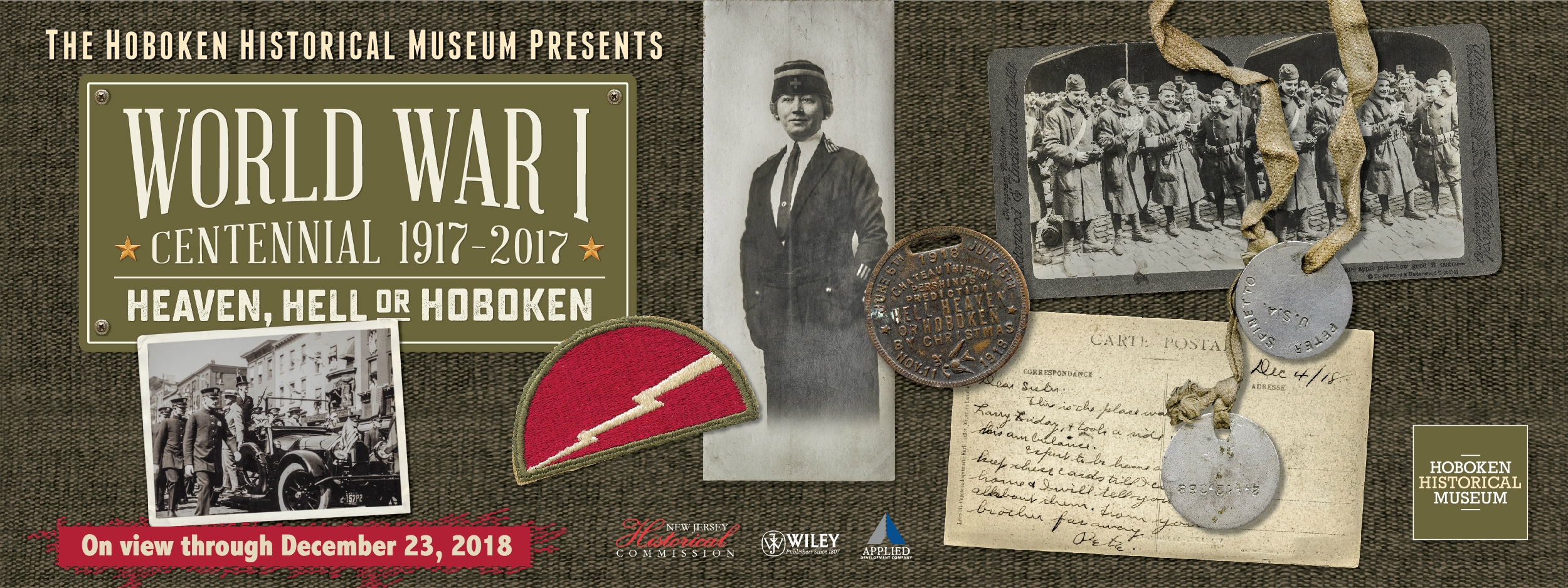World War I Centennial, 1917-2017: Heaven, Hell or Hoboken
August 6, 2017 - December 23, 2018

“World War I Centennial, 1917-2017: Heaven, Hell or Hoboken” explores how Hoboken and its residents were transformed by the United States entry into World War I on April 6, 1917. The city was declared the main point of embarkation for the U.S. Expeditionary Force bound for Europe.
Almost overnight Hoboken became a military town, as hundreds of officers and thousands of enlisted men took residence here to facilitate the logistics of the Embarkation Service. With an additional 14,000 civilian employees, they would oversee the transit of an estimated two million American servicemen to Europe—and then the soldiers’ return—from 1917 through 1919.
Soldiers arriving in Hoboken from boot camps soon began to use the phrase “Heaven, Hell or Hoboken,” referencing John J. “Black Jack” Pershing, the commander general of the Army forces destined for Europe. Pershing had predicted they would be in “Heaven, Hell or Hoboken”—return into America—“by Christmas” 1917.
As the Great War raged on, servicemen retained the saying for Christmas 1918, and when about 5,000 men returned to Hoboken just days before the holiday, the City fathers lined the march route with flags, bunting, and a banner bearing that slogan. The men marched from the trains of the West Shore Railroad, from Jersey City Heights into Hoboken, up First Street, to Hoboken’s waterfront piers, and new destinations—including home. A Jersey City solider, Thomas T. Gavin, told the local Hudson Dispatch: “It certainly is fine to know we accomplished what we set out to do: “’Hell, heaven, or Hoboken by Christmas.’ I am lucky that it is Hoboken.” As he and the returning men marched along First Street, flag-waving residents, gathered in throngs, cheered and sang.
There would be many more returning servicemen and parades, but there would also be sorrowful reckoning and recognition of the soldiers’ great sacrifice, as transport ships increasingly brought back wounded men, and the bodies of those who had died from battle wounds or disease. The influenza epidemic was especially deadly, claiming the lives of nearly as many soldiers as died in combat.
The Great War lasted nineteen months, and many Hoboken men served. Women on the home front also volunteered to assist the war effort in many ways. “World War I Centennial, 1917-2017: Heaven, Hell or Hoboken” displays some of the personal letters, postcards, official documents, and photographs of these men and women, allowing us, 100 years later, to consider their unique perspectives and contributions, and the way the war changed them and their hometown.
— Introduction written by Holly Metz
The exhibition is on view from August 6, 2017 – December 23, 2018. Other highlights in the exhibition include:
- The official ledger book – measuring 3 ft. by 4 ft.! – in which a Hoboken city clerk inscribed the names, addresses and ages of all the men ages 18 – 45 who were required to register for military duty under the country’s first Selective Service Act.
- Twenty-five patriotic posters (on loan from the Jersey City Free Public Library) issued by the US government to rally all citizens to contribute to the war effort, through military service, buying bonds, or conserving food.
- Archival film footage of soldiers and YMCA volunteers busy with preparations for shipping out or returning home.
- An authentic, hand-cranked Victor Victrola, made in Camden, NJ, in 1918, and stereoptical images of the bustling Hoboken waterfront in wartime, with both an original and a modern viewer for enlarged versions of the cards.
- Artifacts from the Warriors’ Shrine at the former St. Paul’s Episcopal Church, on Hudson St. (now a residential condo building), including a sanctuary chair containing a stone from the bridge across the Marne River at Chateau-Thierry in France.
Funds from the David Webster Memorial Fund were used to purchase some artifacts for this exhibition, including items from Peter Spinetto’s estate and the estate of John DePalma. Additional thanks to the Jersey Room at the Jersey City Free Public Library and the Librarians Cynthia Harris and John Beekman. We would also like to thank Ronald Magnusson for his research on Peter G. Spinetto, and the following Museum staff and contributors for making this exhibit possible: Melissa Abernathy, Robert Foster, Rand Hoppe, Eileen Lynch, Holly Metz, and McKevin Shaughnessy.
